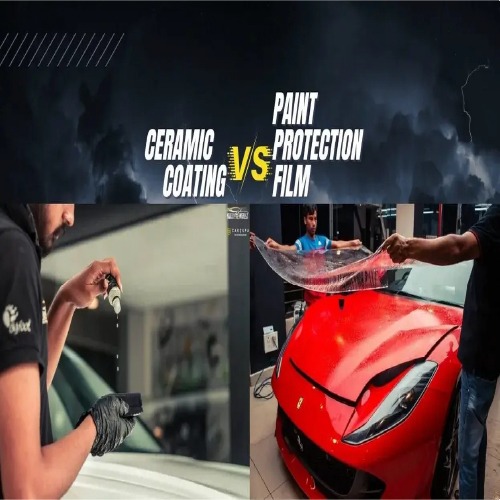
Ceramic Coating vs PPF
In today’s world, protecting your car’s paint isn’t just about aesthetics; it’s an investment. Two popular options for achieving this are Paint Protection Film (PPF) and Ceramic Coating. Both offer advantages, but understanding their differences is crucial for choosing the right one for your car and driving habits.
Understanding PPF:
PPF is a thin, transparent film applied directly to the car’s painted surfaces. It’s made of polyurethane, a highly durable material that acts as a barrier against:
- Physical damage: PPF shields your car from scratches, scrapes, chips, and even minor dents caused by road debris or flying objects.
- Chemical damage: Bird droppings, insect splatter, and UV rays can damage paint. PPF acts as a sacrificial layer, absorbing the damage and protecting the paint underneath.
- Stains: PPF makes cleaning easier as dirt and grime don’t adhere as easily to the film.
Benefits of PPF:
- Superior physical protection: PPF offers unparalleled protection against scratches, chips, and minor dents.
- Self-healing properties: Some PPF films possess self-healing properties, allowing them to heal minor scratches through heat application.
- Long-lasting protection: High-quality PPF can last for 5-10 years with proper care.
Drawbacks of PPF:
- Cost: PPF can be significantly more expensive than ceramic coating, especially for full-car applications.
- Visibility: Installation requires high expertise to ensure a seamless and bubble-free finish.
- Yellowing: Some lower-quality PPFs are prone to yellowing over time, affecting the car’s aesthetics.
Understanding Ceramic Coating:
Ceramic coating is a liquid applied to the car’s paint, forming a thin, transparent layer that bonds with the paint at a molecular level. It offers several benefits:
- Hydrophobicity: Ceramic coating creates a hydrophobic surface, causing water to bead and roll off, making cleaning easier and reducing water spot formation.
- Gloss enhancement: Ceramic coating enhances the car’s paint gloss and provides a deeper, richer shine.
- UV protection: It offers moderate UV protection, slowing down the paint’s fading and oxidation.
Benefits of Ceramic Coating:
- Affordability: Ceramic coating is generally cheaper than PPF, particularly for full-car applications.
- Ease of application: Ceramic coating can be DIY-friendly or professionally applied, making it a more accessible option.
- Hydrophobic properties: Makes cleaning easier and reduces water spot formation.
Drawbacks of Ceramic Coating:
- Limited physical protection: While offering some scratch resistance, it doesn’t provide the same level of protection against physical damage as PPF.
- Durability: Ceramic coating typically lasts 1-3 years, requiring reapplication to maintain its benefits.
- Maintenance: Maintaining the hydrophobic properties requires regular washing and using specific car care products.
Choosing the Right Option:
The ideal choice depends on your priorities and driving habits. Here’s a quick guide:
- Choose PPF if:
- You frequently drive in areas with high risk of physical damage (e.g., gravel roads, tight parking spaces).
- You prioritize long-lasting protection against scratches, chips, and dents.
- You value self-healing properties and ease of maintenance.
- Choose Ceramic Coating if:
- You prioritize affordability and a smoother application process.
- You value water repellency and a deeper shine for your car’s paint.
- You drive in low-risk environments and are comfortable with reapplication every few years.
Conclusion:
Both PPF and ceramic coating offer distinct advantages. Consider your budget, driving habits, and desired level of protection when making your decision. Consulting a professional detailer like CarsBuddy can also help you understand the specific products available and their suitability for your car. Remember, the best option is the one that best protects your car and aligns with your needs.

